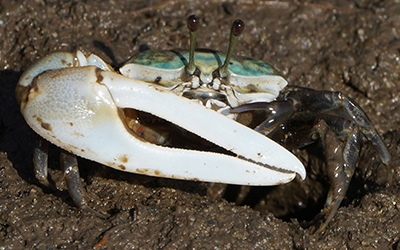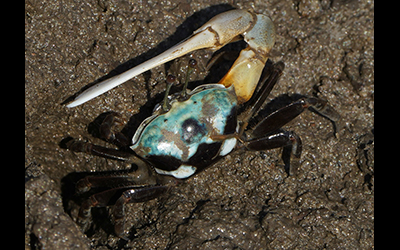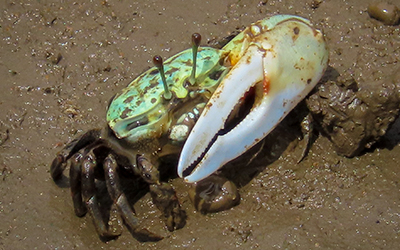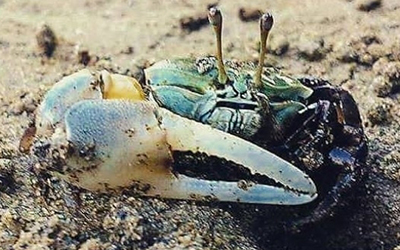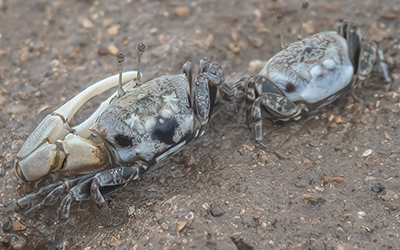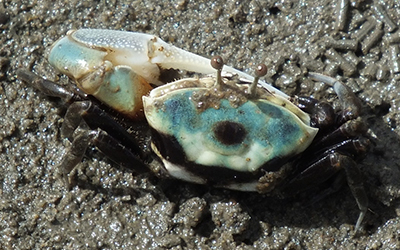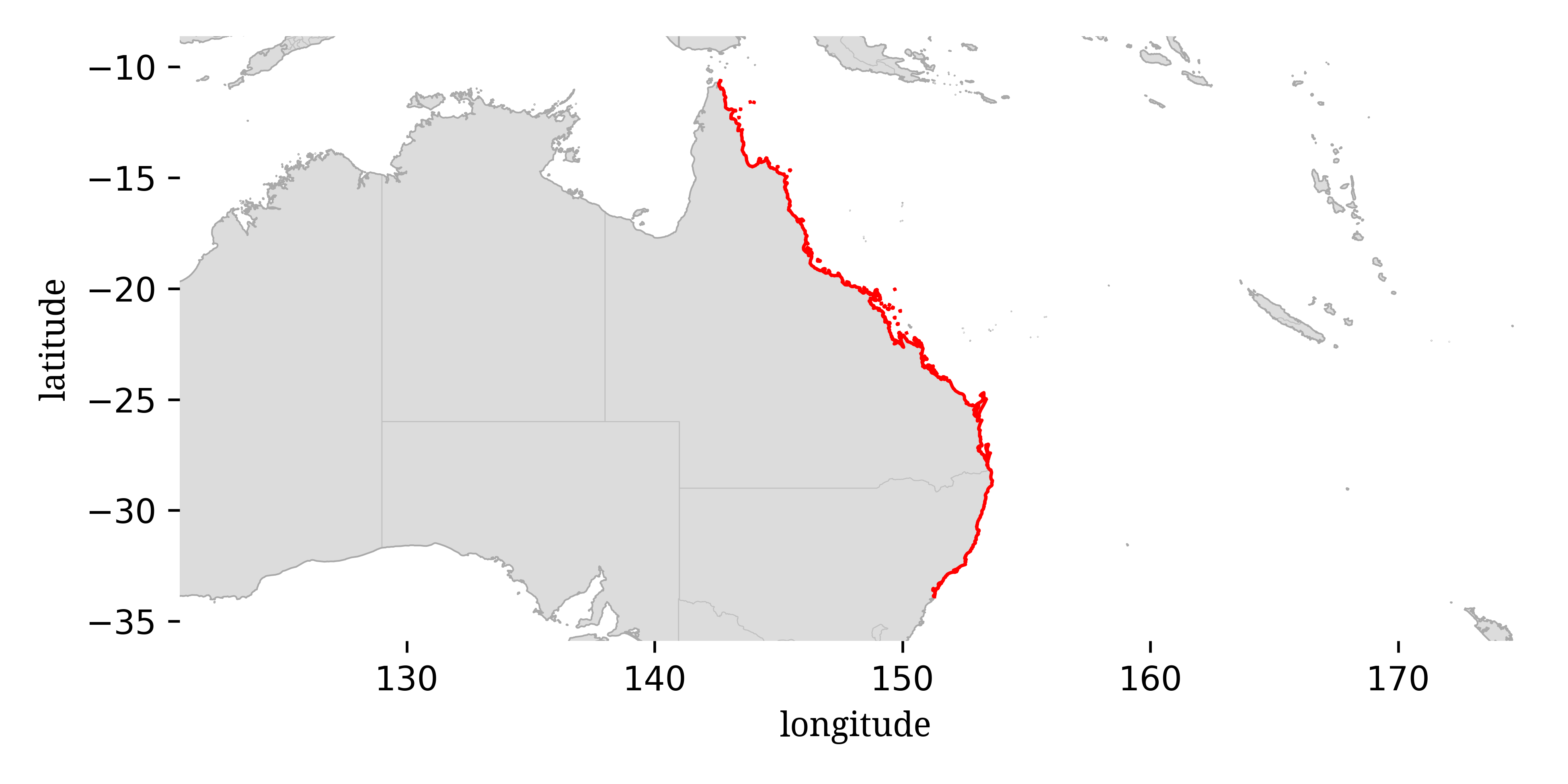
This guide is designed for identification “in the field” where you might be looking at live crabs by eye or through binoculars or from photographs. I will generally try to avoid characters that will require you to physically catch the crab, although I may mention a few for secondary verification. It does not include the more strict taxonomist-style characters that may only be visible under a microscope or via dissection. It is also assumed that the individuals are living, as death (and even capture) can cause dramatic color change.

This is a guide to the fiddler crabs of eastern Australia, including New South Wales and the eastern half of Queensland (east of the Cape York Penninsula/Torres Strait). There are 11 species in this region:
All of these species are found in eastern Queensland; traditionally only a few were commonly found in New South Wales (Austruca perplexa and Gelasimus vomeris in particular), with a few stray reports of others, but in recent years there is mounting evidence and observations of more of these species in the south, including Tubuca coarctata, Tubuca dussumieri, and Tubuca longidigitum. The southern extent of fiddler crabs in New South Wales is the southern part of Botany Bay, just south of Sidney.
A number of features can be used to distinguish among these species, but a good place to start is to look at the distance between the base of the eyestalks. Fiddler crabs tend to split into two groups, those with the eyestalks very close together (“narrow front”) and those with the eyestalks separated a bit more (“broad front”). Three of these species (Austruca perplexa, Austruca triangularis, and Paraleptuca crassipes) are broad front species, while the other eight (Gelasimus tetragonon, Gelasimus vomeris, Tubuca coarctata, Tubuca dussumieri, Tubuca longidigitum, Tubuca polita, Tubuca seismella, and Tubuca signata) are narrow front species. Note that the carapace between the eyestalks appears pinched together in the narrow front species, but more trapezoidal in the broad front species.
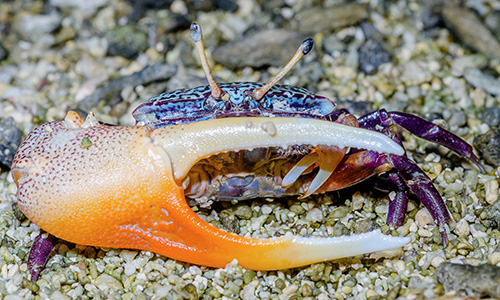
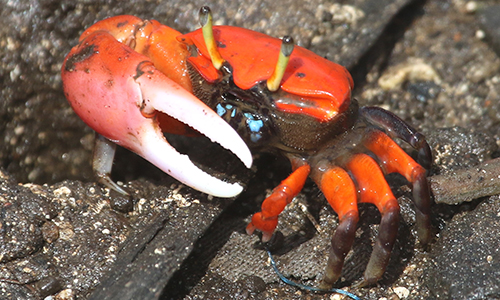
The three broad front species in this region should be fairly easy to tell apart, as they have little overlap in color patterns, although one of them has some similarity to a narrow front species described below. Austruca triangularis and Paraleptuca crassipes appear to be relatively rare within Australia and are only known from the northeastern part of Queensland, roughly between Cairns and Cooktown. In contrast, Austruca perplexa is found along most of the eastern coastline.
Austruca perplexa generally has a black and white carapace, frequently with semi-solid bands, and a yellow-to-white large claw. These colors are very similar to Austruca triangularis; differences are described below.
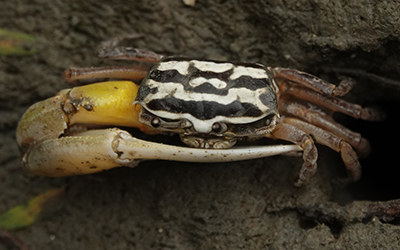

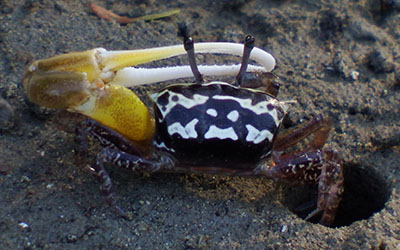
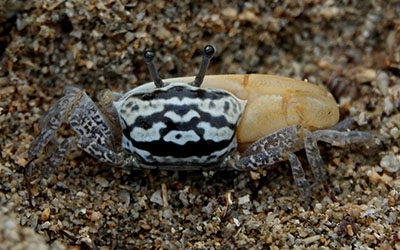
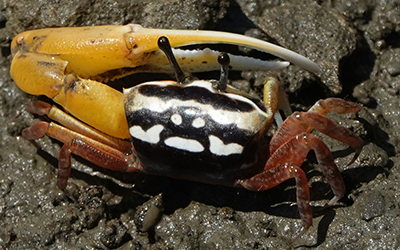
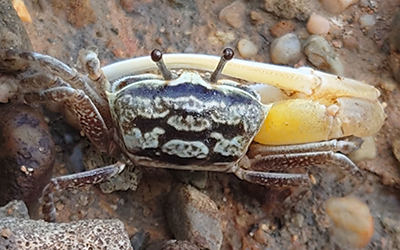
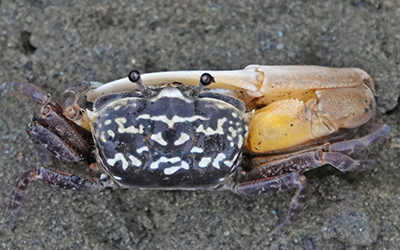
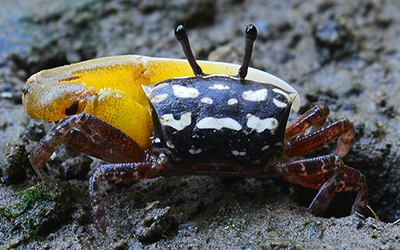
Austruca triangularis has similar colors as Austruca perplexa, generally having a black/brow and white/cream carapace (occasionally yellow), frequently will broad stripes, and a claw which tends to be off white, but may include yellow. Despite this general similarity, the species should be relatively easy to tell apart.
There are at least three features which can be used to distinguish them. First, the carapace shape is noticably different, with the front corners of the carapace of Austruca triangularis extremely pointy and tending to point more toward the sides than the front, with the sides of the carapace converging much more strongly in Austruca triangularis than Austruca perplexa. Second, the hand of the large claw in Austruca triangularis is generally covered with brown spots, giving it a polka-dotted appearance (these spots are sometimes foundon the carapace as well). Third, but more subtle, on average Austruca triangularis tends to be smaller than Austruca perplexa, although the two species overlap in size.
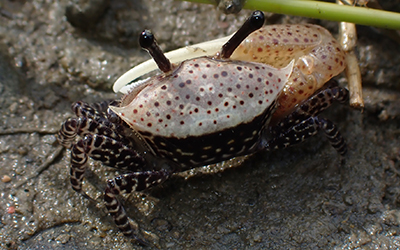
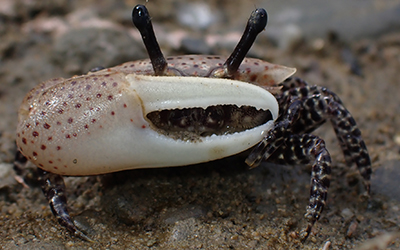
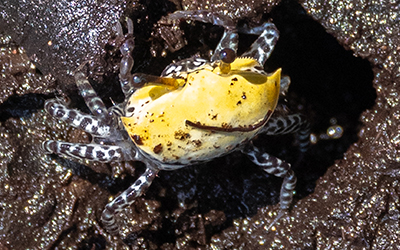
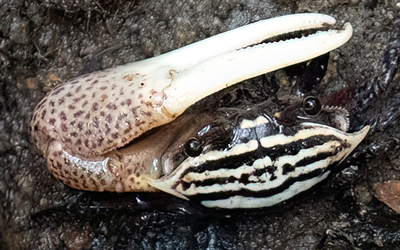
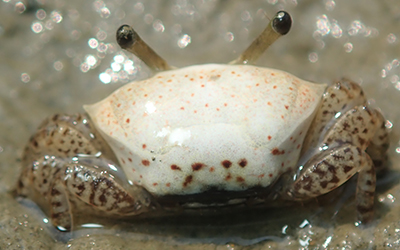
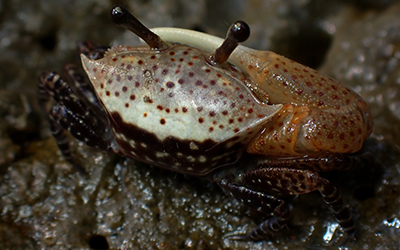

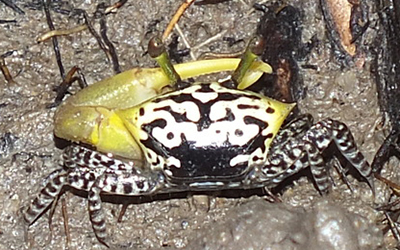
The final broad front species in this region, Paraleptuca crassipes is easily distinguishable from the others by color. The colors of Paraleptuca crassipes do overlap with one of the narrow front species, Tubuca coarctata, described below.
Paraleptuca crassipes is a highly variable species with a carapace that is generally some combiantion of black, pale blue, and bright red—occasionally with a hint of yellow or green—with solid red and all-but-solid black carapaces not uncommon (it seems never to be solid blue). It's eyestalks are usually yellow-green, but sometimes red, particularly in individuals with heavily red carapaces. The large claw is bright red-to-reddish pink, with paler pink or white fingers.
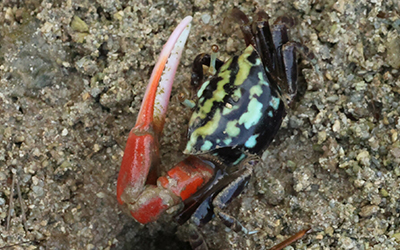
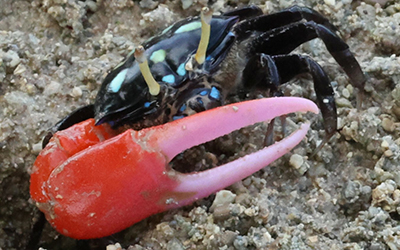
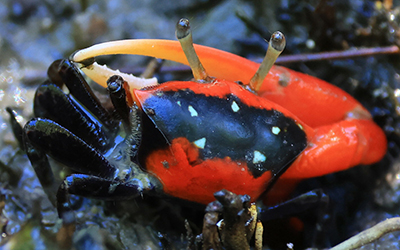
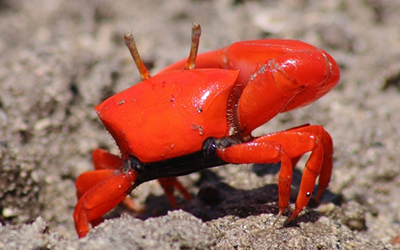
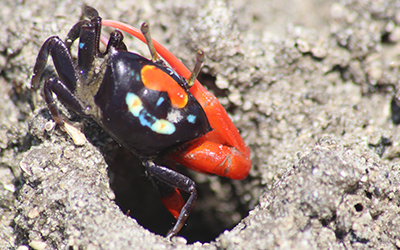
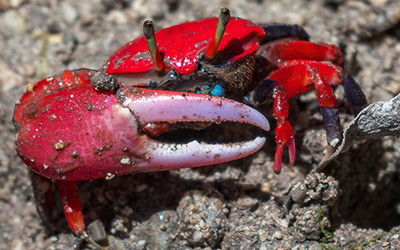
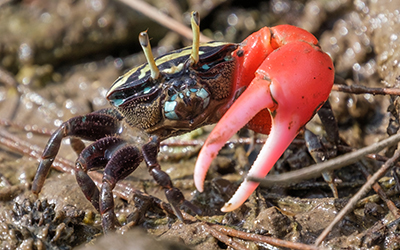

Gelasimus vomeris is a wide spread and easily recognizable species in eastern Australia. Among the narrow front fiddler crabs in this region, it is among the easiest to identify as it is the only species of the subgenus Gelasimus (Gelasimus) in the area and has the typical colors and claw shape associated with that subgenus, although it it sometimes confused with Tubuca coarctata.
Its large claw is strikingly two-toned, generally orange on the bottom half and white or pink on the upper half; sometimes there is a darker orange spot around the base of the lower finger. There is a large triangular depression around the base of this finger as well, that is frequently outlined in mud. Its carapace is usually a mix of pale blue or white and black, although other colors, including green and brown are possible. Its legs tend to be brown or gray. The lower finger of the large claw generally has a large tooth near the tip, although regenerated claws may appear smoother and toothless.
The small claws, on both males and females, is frequently orange.
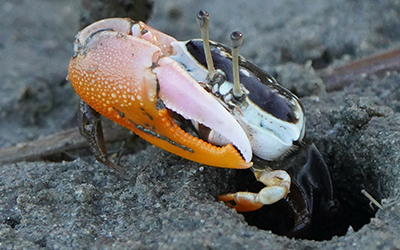
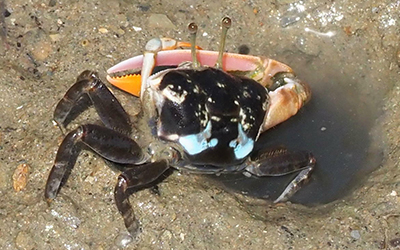
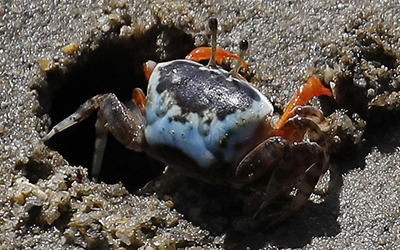
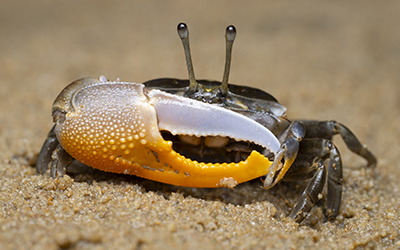
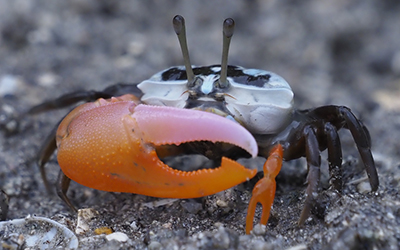
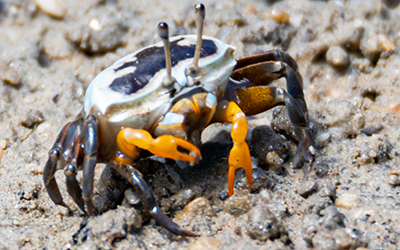
Juvenile male Gelasimus vomeris lack the color of the adults, having gray/brown speckled carapaces and a large claw that is mostly white (with only perhaps a tinge of orange near the base of the lower finger), and only a small suggestion of the tooth at the tip of the lower finger. The lower and outer edges of the triangular depression of the large claw are frequently outlined with mud, helping identify these juveniles to this species.
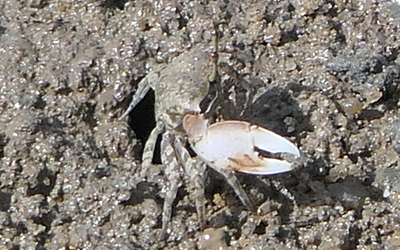
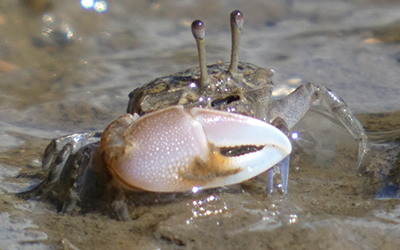
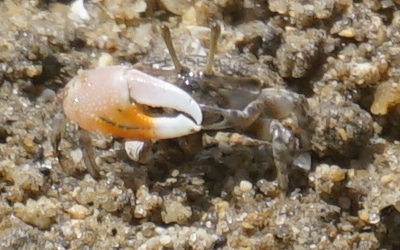
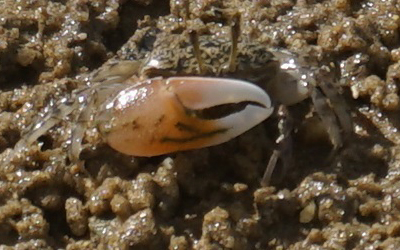
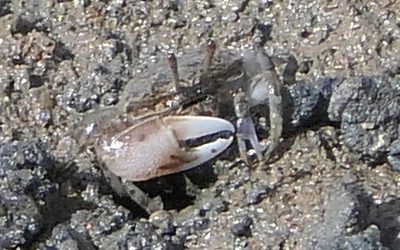
Gelasimus tetragonon is a wide-spread species that is something of an oceanic island specialist, although it is occasionally found on continental shores. It is a rare occurence in Australia, having only been found in the northeastern part of Queensland (north of Cairns) in recent years. It usually has a predominantly blue and black carapace with bright red legs (which occasionally may be darker) and gray eyestalks. The large claw of Gelasimus tetragonon is usually orange, with a noticeably darker red spot near the base of the pollex, and a white dactyl. Gelasimus tetragonon frequently has brown spots on the top part of the hand of the claw.
Gelasimus tetragonon has a lot of additional variability. In some places the carapace can lighten so that there is almost no blue, just a cream or pale orange with black markings. The pattern of the colors on the carapace can vary from stripes or blotches to tiny spots.
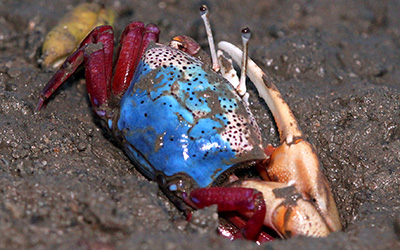
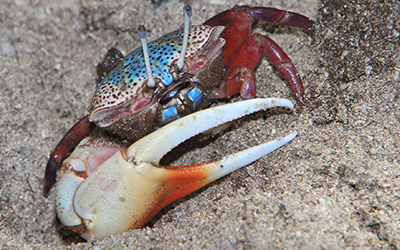
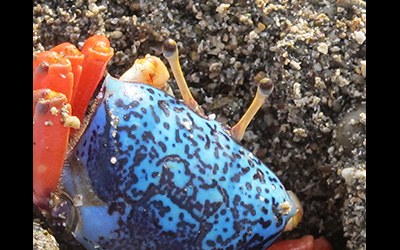
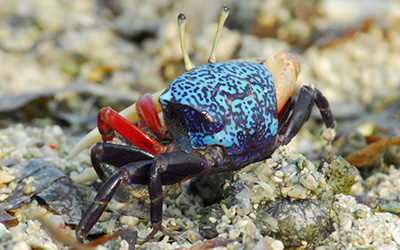
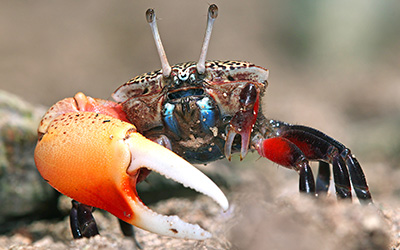
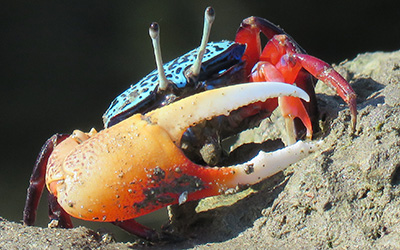
Tubuca coarctata is a highly variable narrow front species that is most likely to be confused in this region with Tubuca dussumieri or the broad front species Paraleptuca crassipes. Differences between Tubuca coarctata and Tubuca dussumieri will be described below, so this section will focus more on Tubuca coarctata vs Paraleptuca crassipes. On average, front breadth might be the easiest way to distinguish these as the high variaiblity of both species creates a lot of general overlap in color pattern.
The most common carapace pattern in Tubuca coarctata is a mostly black carapace with some spots of pale blue, yellow, red, or white. In many cases, however, individuals may have carapaces that appear nearly solid of any of these colors or consist more of two-toned stripes of two of these colors (the latter pattern might be more common in females than males).
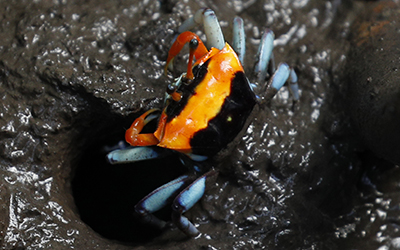

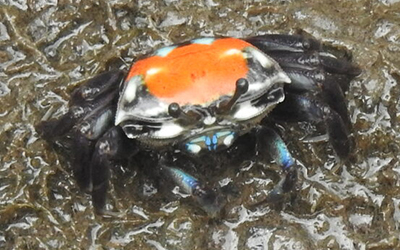
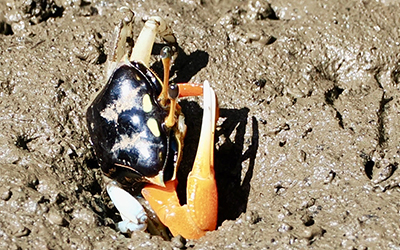
The legs of Tubuca coarctata generally follow this same color variation as the carapace, although the two rear legs generally have a large distinct, pale blue (sometimes almost white) blotch on the rear of the the top segment. This color will sometimes spread beyond this segment.
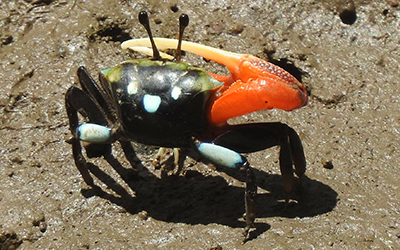
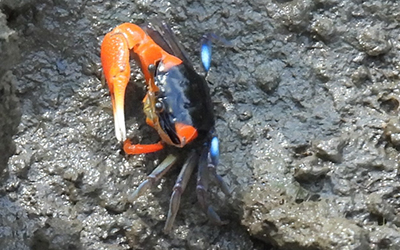

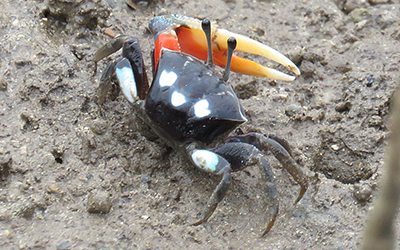
The large claw usually has a red or orange hand, with most of the upper finger and the outer half of the lower finger white. Sometimes the white will bleed further onto the upper part of the hand. There is also usually a darker red patch at the base of the lower finger (as is common in many other species). The prototypical male Tubuca coarctata has a distinct an obvious flat edged projection along the lower portion of the tip of the upper finger of the large claw. In some individuals this feature is more subtle, while other species may have a claw shape that is at least somewhat similar, although within this region this shape is more-or-less unique to this species.
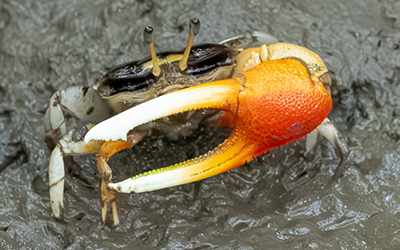

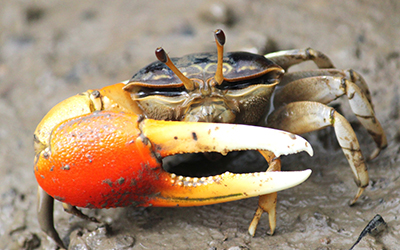

Other than front breadth, the most likely methods of distinguishing Tubuca coarctata from Paraleptuca crassipes are the shape of the tip of the large claw and the presence of the blue spots on the backs of the rear legs. Paraleptuca crassipes also leans much more heavily toward bright reds than Tubuca coarctata, whose redder forms are more orange.
Within Australia, Tubuca dussumieri is primarily found in eastern Queensland, although there is at least one established population in New South Wales around South West Rocks (approximately halfway between Coffs Harbor and Port Macquarie).
Tubuca dussumieri lacks the extreme variability of Tubuca coarctata but overlaps in color. Tubuca dussumieri generally has a dark blue or black carapace, frequently solid colored although some spotting is possible, which can be similar to that found in Tubuca coarctata, including occasional pale spots on the rear legs.
The large claw of male Tubuca dussumieri is generally two-toned, orange on the bottom and white on the top, with a darker orange/red patch at the base of the bottom finger. The fingers of the large claw tend to be fairly straight, and the upper finger lacks the distinct flattened edge that tends to be found in Tubuca coarctata. There may be some flattening of that finger tip in Tubuca dussumieri, but it is more subtle than that of Tubuca coarctata.
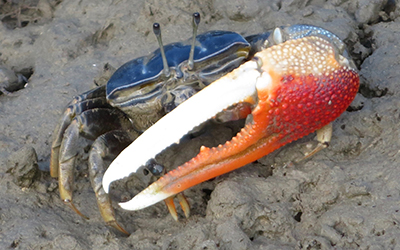
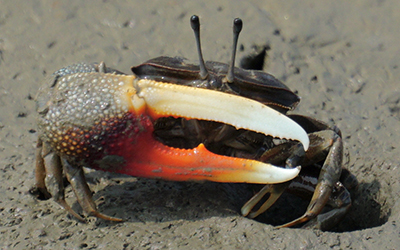
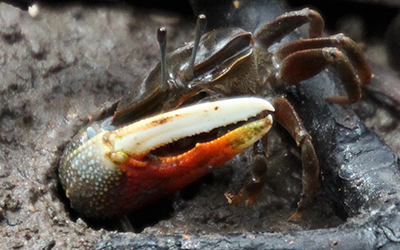
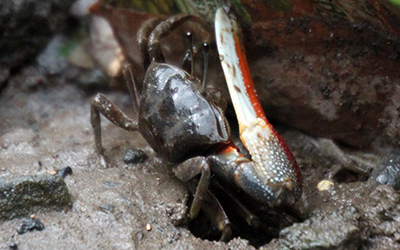
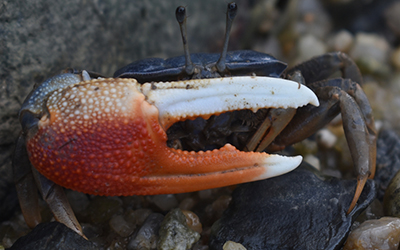
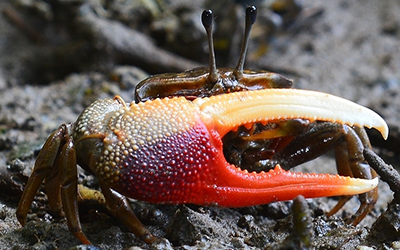
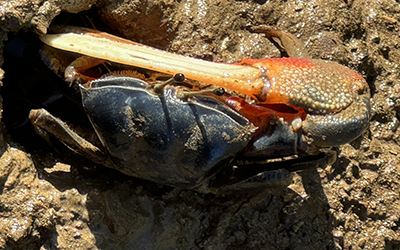
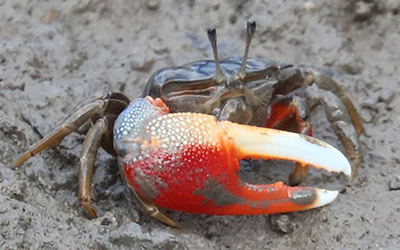
A final feature that distinguishes the two species may be too subtle to see in most cases, but is worth mentioning. Tubuca dussumieri has two long grooves running across most of the length of the upper finger of the large claw; Tubuca coarctata only has one. Unfortunately, these grooves are not always readily visible, particularly as the pale upper fingers of the claw frequently appear slightly overexposed in photographs.

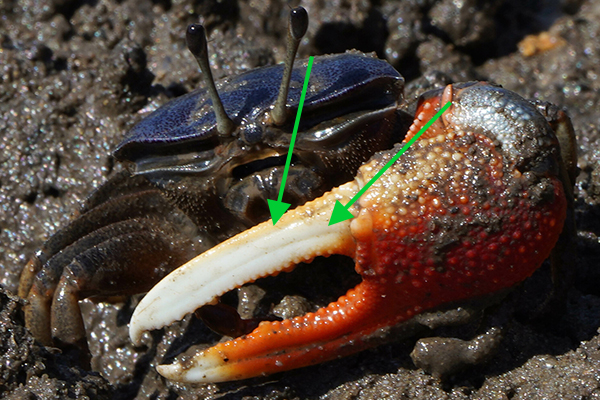
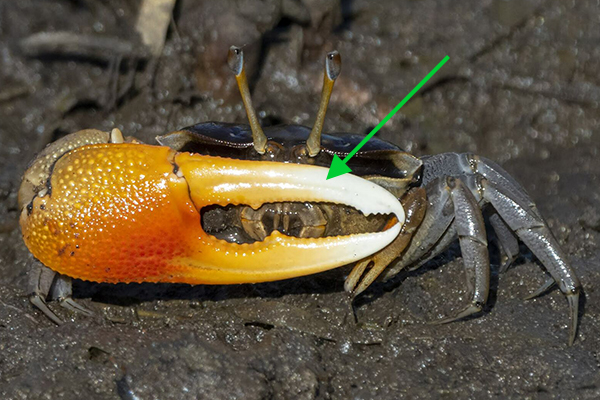
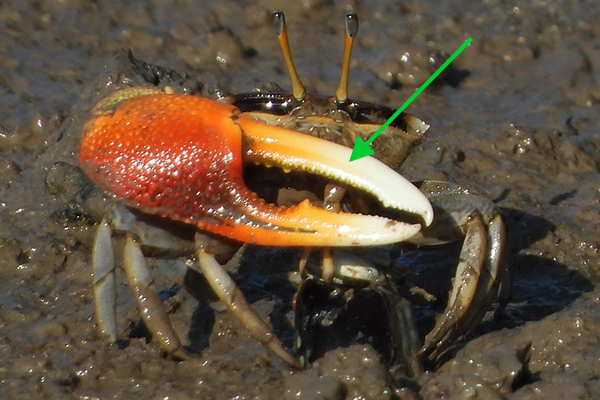
Tubuca signata has a pale blue/white and black carapace. The claw is striking in that the hand is bright red, while the fingers are bright white. The demarcation between the color of the hand and the fingers is particularly strong in this species. The fingers tend to be long relative to the hand, appear particularly flattened and smooth, and frequently come together along a long straight edge on the bottom finger.
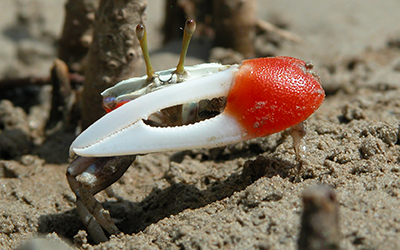
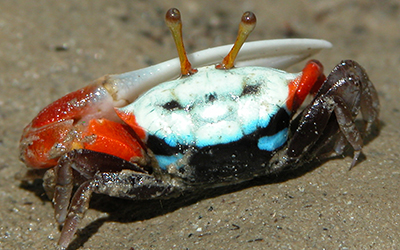
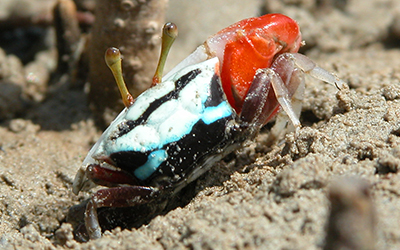
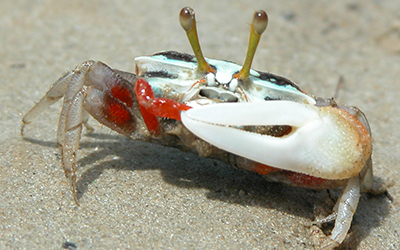
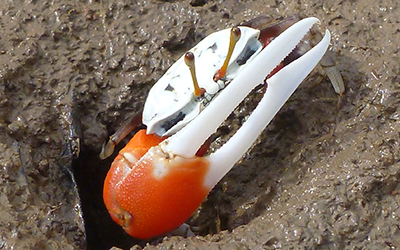
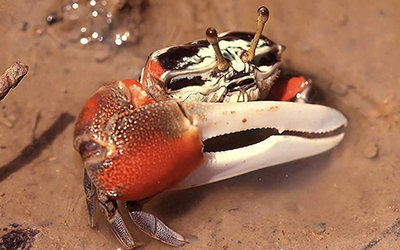
Tubuca polita has a predominantly black and cream carapace, occasionally with some greenish-blue blotches. The large claw of Tubuca polita is pink/red, with paler fingers, but the pink coloration frequently extends a bit onto the fingers.
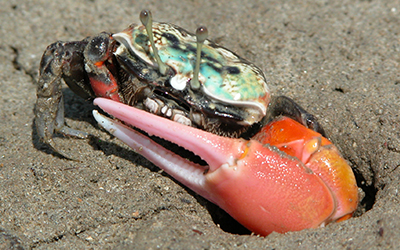
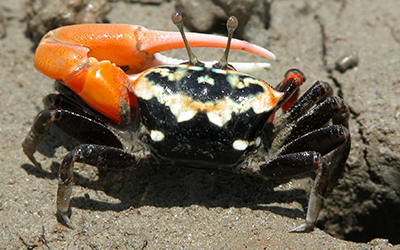
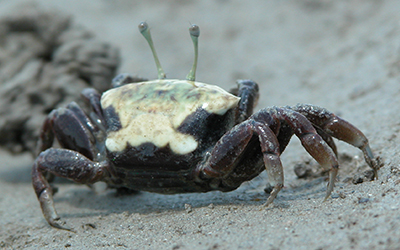

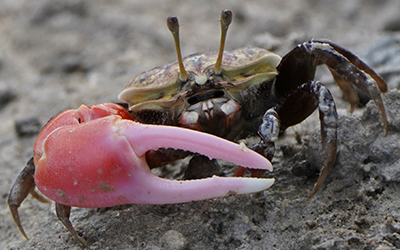
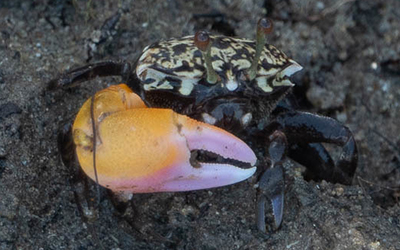
Tubuca seismella lacks the brighter colors of its cousins. Its carapace is a light marbled brown or gray, frequently with lighter speckles, and its large claw tends to have a pale peach/pink hand with white fingers. The fingers have a similar flattened and smooth appearance as found in some of the other local species, but the general coloration of the species is very different.
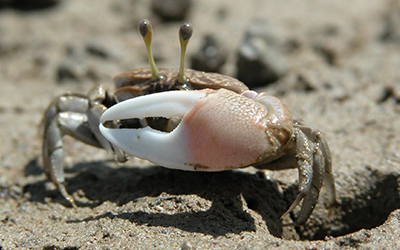
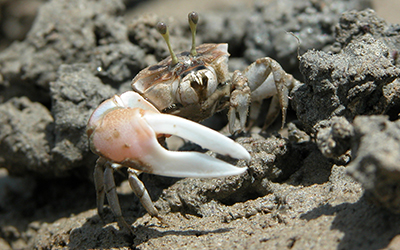
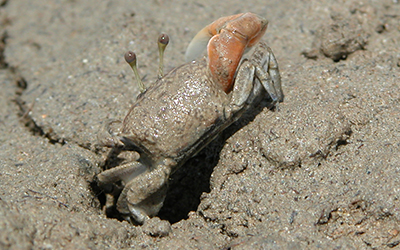
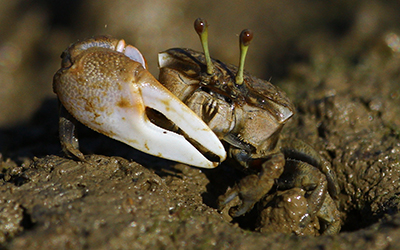
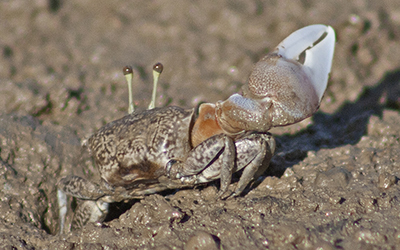
Tubuca longidigitum is a somewhat obscure species found primarily in southeastern Queensland, but with at least one known occurrence in New South Wales.
Tubuca longidigitum has a turquise-blue carapace with black and white markings. Males generally have three large black diamond blotches on the rear part of the carapace. Its large claw tends to be almost entirely white (or pale gray and white) with long, flat, and smooth looking fingers. It is most similar in appearance to Tubuca signata, but lacks the bright red common to that species. It is also the only species in Australia whose large claw tends to appear almost entirely white (or white/gray), at least as adults.
